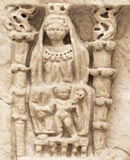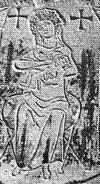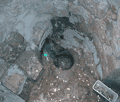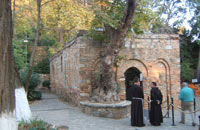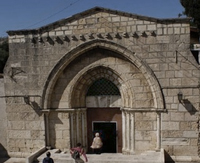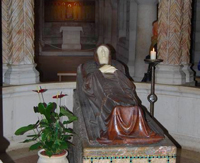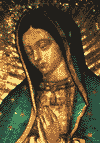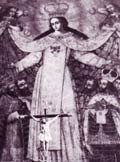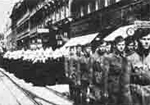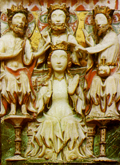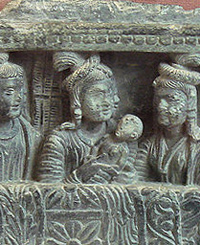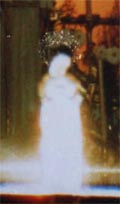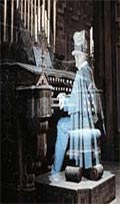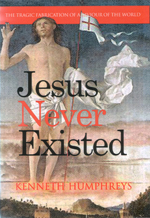
Discuss the world's favourite imaginary friend on the JNE YouTube channel
Isis – Mother of God
Isis with Child – prototype of 'Mother of God'
Mother and Child, Roman style
Magna Mater (Ostia, Rome).
Cybele, the Great Mother with the child Attis
Attis castrated himself, bled to death, and, after 3 days, was restored to life as a tree. Hence, a spring-time fertility festival.
Sound familiar?
Vesta – Female Protector of Rome'As the ancient, everlasting guardian of Rome and its rulers, Vesta in these dangerous times received more devoted veneration than ever.'
– Michael Grant, The Climax of Rome, p168.
Isis has become a Christian!
Coptic 'Madonna and Child' from the Fayum, Egypt.
Was it here? (Greek Legend)
Mary's Well, Nazareth
Or Was it here?
(Catholic Legend)
Mary's Grotto, Nazareth

Some confusion as to where the angel Gabriel announced the divine pregnancy!
Last House of Mary, Ephesus?
Mary has a house on a mountaintop near Ephesus.
Apparently, it was built by the apostle John. What a fisherman.
Mary's Tomb, Jerusalem?
Footings of the Church are datable to the 5th century though the franciscan priest Bagatti (see Nazareth) claimed to have found evidence for a 1st century cemetery. You bet he did.
Mary's other crypt?
Can a girl ever have enough final resting places? Crypt beneath the Abbey of the Dormition.
Virgin Queen
"Indeed, it was after the Second World War that the cult of the Virgin reached its apogee.
In 1950 Mary's bodily assumption into heaven became dogma; in 1945 Pius XII had proclaimed her Queen; while in 1964 – after the commencement of the Second Vatican Council – she became Mater Ecclesiae ...
These things tell us much about the role of woman in patriarchal culture."
– D. Hampson, After Christianity, p175/6.
"Our Lady of Guadeloupe"
What a Girl! Mary conveniently turned up in 1531 to help the murdering conquistadors.
"She appeared to Juan Diego when it was apparent that the Church was making very little headway with the natives of the New World."
– Roy A. Varghese (God Sent, p44)A timely apparition – and a good measure of violent terrorism – secured the conversion of 8 million Aztecs.
Big Mama
Giant Mary towers over diminutive Christ – (17th century, Peru)
Hail Mary!
The "Angelical salutation" (the "Ave Maria" or prayer to Mary) first became widespread in the 12th century.
Nuns march behind Croatian Nazis (inspired by Mary?)
"And Hannah prayed, and said, My heart rejoiceth in the Lord, mine horn is exalted in the Lord: my mouth is enlarged over mine enemies; because I rejoice in thy salvation. There is none holy as the Lord ...
The bows of the mighty men are broken, and they that stumbled are girded with strength ... they that were hungry ceased: so that the barren hath born seven; and she that hath many children is waxed feeble.
The Lord maketh poor, and maketh rich: he bringeth low, and lifteth up.
He raiseth up the poor out of the dust ...The adversaries of the Lord shall be broken to pieces ."
(1 Samuel 2.1,10)
From Merest Shadow to Queen of Heaven Who? Scripture may have very little to say about Jesus; it has even less to say about his supposed mother. For the earliest Christians ‘Mary Mother of Jesus’ almost did not exist: they were not interested in the nativity of their god-man – it was his re-birth after death that mattered. Paul does not mention Mary (or Joseph) at all, and in the gospels, the shadowy figure of Mary, destined to become the most pre-eminent of all the saints and Queen of Heaven, at best, is a two-dimensional nonentity. In the gospel pageant, ‘Mary’ appears in several scenes. In all of them she is a passive character, habitually in the background and virtually without a voice (she speaks in total three times, twice in a single sentence). She is not described (but then, none of the gospel characters are!); nor do we know her age. She is a bit player, primarily with ‘witnessing’ parts. We learn nothing of her origins, save for the family connection to cousin Elizabeth and as betrothed of Joseph. She appears first in the so-called ‘Annunciation’ (at the well ..?) when an angel maps out her career. With little ado, she accepts the ‘blessed’ role revealed to her (Luke 1.38) and rushes off to spend three months in the mountains with the pregnant Elizabeth (she who will mother John the Baptist). In this, her biggest scene, Mary delivers her only set-piece speech (such articulation at this gob-smacking moment!) – the so-called 'Magnificat':
Pagan Model Yet upon this sketchy outline a full-bodied character was to be fleshed out soon enough by ‘creative’ Christian scribes. Pagan gods, as often as not, were supposedly sired by virgin goddesses – quite commonly as a result of impregnation by a sun-beam. The resultant sun-god was depicted as an infant at the breast of his mother – the ‘Madonna and Child’ no less! Such iconography is to be found all the way from Egypt to China. The Romans' own virgin goddess, Vesta, was served by women who maintained her perpetual flame and their own chastity for thirty years. The ‘Mary’ of the Christians considerably upstaged this achievement by the double whammy of mothering a god and maintaining her virginity for two millennia! But it was to take a few centuries of creative story telling for all the paraphernalia of the pagan myths to be fused into the Christian one. Rather like a delayed echo of the invented life of the illustrious super-hero himself, Mary’s own ‘biography’ blossomed over the centuries. Early Christian writers, like Justin and Irenaeus, elevated Mary as a ‘second Eve’, her ‘obedience’ reversing the sin of the original garden dweller. Justin ‘Martyr’, a Greek from Palestine who had fled to Ephesus at the time of Bar Kochbar’s revolt, adopted the embryonic Christianity he found in the city with relish. But Justin’s enthusiasm came with a prior familiarity of Greek classics. In his adopted city the venerable cult of the moon goddess Artemis (or Diana as the Romans called her) had been the eternally virgin protector of youth, chastity and fertility for a millennium. In the process the city had become a wealthy place of pilgrimage – the world’s first bankers had been the priests of Artemis.
Becomes a Virgin Justin set about infusing his Christianity with aspects of the rival cult. Despite the opposition of ‘established’ Christians, Justin insistently embellished the skimpy biblical Mary story with the idea that Mary had delivered a ‘Virgin Birth’. This belief, so he himself admitted, was based solely on ‘predictions set forth by the blessed prophets’, in other words, upon the notorious mistranslation of Isaiah 7.14 (in which ‘virgin’ was substituted for ‘young woman’; see: Lying for God – Virgin Birth Fraud) to be found in the Septuagint. In the context in which upstart Christianity was competing with a far more ancient faith, it is no surprise that the Christ followers eventually settled on a ‘Virgin Birth’. The ‘miraculous’ arrival provided a useful rebuttal to early critics of the Christians, who were suggesting that if the Jesus figure had ever existed, he had a rather dubious parentage. The next major contribution to the Mary legend came in the mid-second century, with the so-called ‘Protevangelium of James’, a document so clearly fictitious that it has been rejected even by the Catholic church since the Renaissance. Nonetheless, this pious nonsense underpins much of current belief regarding the Blessed Virgin, providing such information as the names of Mary’s parents and grandparents, a story of her prodigious childhood ("left at the Temple from the age of three" – an event without precedent in Jewish custom!); her early commitment to chastity (why – did she know what was coming?); daily chats with angels; and a ‘safe’ marriage at puberty to the elderly widower Joseph. With this embellished ‘history’, Mary began her ascendancy as a mediator, more approachable than Christ because of her ‘humbling’ femininity. Artistic representations of her began to proliferate, uncannily like the prototype they were based upon – Artemis, the goddess with more than a thousand years of marketing success behind her! A century later the ‘Gospel of the Nativity of Mary’ (well, we can never have enough gospels, can we?) added background detail. This story of Mary’s birth to ancient parents Anne and Joachim was a simple re-write of Samuel’s birth to Hannah and Elkanah already to be found in 1 Samuel. But now we learn of such delights as Mary’s grandmother’s seven marriages. Six husbands were dispatched by the Lord for feeling lust while having sex. Thankfully the seventh was inert during the sinful act, or we would not have had Anne, Mary, Jesus and the whole nine yards!
Though the gospels clearly stated that Jesus had four brothers and two (unnamed) sisters the theologians of Christ were disposed to argue that the virgin "purity" of their goddess was not to be compromised: she had, they insisted, remained a virgin throughout the whole birthing process.
The fourth century was particularly favourable to the thriving Mary cult, largely thanks to the peripatetic activities of the Empress Helena. As mother of Constantine, she probably felt a particular affinity with the original mother of a Lord of the World. Helena positively invented ‘ecclesiastical archaeology’ (or at least the shrine-creation business). Everywhere she went in the ‘Holy Land’ she found ‘evidence’ of Christ and ordered the construction of churches at the spot: the cave of the nativity (or so the locals said), the house of the last supper (or so the locals said), the garden of Gethsemane (or so the...), the hill of crucifixion, the empty tomb, the cross itself, even the very tree from which the wood was cut! And sure enough, Helena ‘found’ the very location (a cave) in Nazareth where the angel Gabriel had made his ‘announcement’ to Mary. Like every other shrine it thereafter became the recipient of imperial patronage and profitable pilgrimage. With the shrine went a Mary festival, the ‘Annunciation’. Unfortunately for the town of Capernaum – supposedly the chief site of Jesus’ ministry – Helena did not get that far – and the town was lost to history!
Immaculate Deception In the fifth century, the Council of Ephesus (431 AD) accorded Mary the title ‘Theotokos’ (‘Mother of God’).
Ephesus, of course, had long been the home of the Mother of God, though through that period she had been happy with the name Cybele, the mother and consort of the dying/reborn god Attis. In the Roman period the Phrygian Cybele was conflated with the Greek Artemis. With a certain amount of desecration and rebuilding, the sanctity business continued as usual. The Byzantine Romans had a particular affection for court ritual and regalia and Mary as a queen, complete with crown and sceptre, appealed much more to imperial appetites than a shadowy peasant woman. Like Jesus himself, she had ‘gone royal’ and was elevated into the sainthood.The sixth century Council of Constantinople (553 AD) went on to endorse as dogma Mary's "perpetual virginity". The "purity" of virginity, it seems, is closer to the "purity" of God.
Getting a Death or two The first four hundred years of Christian testimony are silent regarding the end of the Blessed Virgin. But after the Council of Ephesus the 'tradition' emerged that, following on from JC's instructions from the cross, the disciple John had taken Mary to Ephesus – surprise, surprise! – and had built her a house in which to live out her days. Glory be, you can still visit it!
By the seventh century, creative writers had replaced the limp ending of the Mary story with something altogether more satisfying. John Damascene (together with Gregory of Tours) developed the idea that Mary’s corporal body (and not just her spirit) had been ‘assumed’ into Heaven (again, paralleling the career of her illustrious son). John lived in Umayyad Damascus and his inspiration may well have been the claim made by upstart Islam that Muhammad had 'ascended to Heaven', supposedly in the year 620 (Qur'an, surah 17.1). The doctrine of Mary's Assumption was defined as dogma as recently as 1950 by Pope Pius XII. In his Munificentissimus Deus, the pope left open the question of Mary's actual death, with the result that Catholics differ on whether Mary actually died before she was "assumed" into heaven and, if so, whether her soul arrived three days ahead of her body. The Orthodox Church uses the word Dormition for the same preposterous event.
Rise and Rise In 787 the prelates and bishops again convened in Nicaea. Mary's continuing promotion was once more on the agenda. Earlier in the century, with relentless pressure coming from Islam, two emperors – Leo III (717 - 741) and his son Constantine V (741 - 775) – had outlawed "idolatry" and its plethora of "holy icons". But their "iconoclasm" had wiped out much of the income of hundreds of monasteries and shrines and had set the Orthodox Church against the imperial court. Empress Irene, acting as regent for her young son, Constantine VI, caved in to religious pressure and convened the 7th Ecumenical Council. The Council energetically endorsed the acceptance of icons, and in particular the worship of Mary:
Sinless In the first writing of the birthing of Mary, she is no more ‘immaculate’ than anyone else (and we all know original sin is passed on by sex). All the early Church Fathers agreed that Christ alone had been born without sin. They had no doubt: Mary had been a sinner. However, since Mary’s womb represented a temporary home for the gestating superhero a tainted womb raised theological difficulties about purity – if, that is, one stopped to think about such things. In the 7th century an emerging Islam – which quite happily adopted "prophet Jesus", Mary and her virginity – made its own contribution to the fabulous legend. According to a tradition of Muhammad every new-born child is 'touched' by Satan. But for Mary and her illustrious son, God interposed a protective veil. This notion of Mary's (and not just Jesus's) sinlessness percolated back into Catholicism. Wrote Edward Gibbon:
Only in 1854 could the world be sure that Mary had been ‘conceived normally but without sin’! Until then, ‘perpetual virginity’, the nonsense developed by Jerome and Athanasius in the fourth century, had sufficed to vouchsafe Mary’s purity. Already a goddess, its hardly surprising that outbreaks of Marian miracles were endemic throughout the Middle Ages (and continue in our own time!) Less than God himself but considerably more than human, blessed as a female with infinite ‘humility’, she was seen as an intercessory to whom mere mortals could appeal on ‘lesser’ matters. She was, quite simply, the most important woman that had ever lived. The cult was unstoppable. Whereas most saints had only one holy day or feast, the Holy Mother had one every few weeks and her own chapel in every church in Christendom. Eventually, even the Catholic Church had to call a halt to the galloping fantasy by reminding the faithful that Mary had to be seen as ‘completely dependent on the Son’. But it was all too much for the Protestants of the Reformation. In their hands Mary was reduced once more to a passive, obedient role, a shadow, somewhere in the background. Defined by her virginity, lauded for limitless humility and submission, she is the idealized woman of misogynistic fanatics, in her own words a ‘handmaid (i.e. slave) of the Lord’.
Queen Maya With Infant Buddha.
The Blessed Virgin Mary – A Saint for All Seasons The phantom of a 'Holy Mother' has proved quite an earner for the Church of Rome, more tangible than the 'Holy Spirit' (a tad difficult for the iconography), more approachable than Christ Almighty. Having hijacked the 'sacred feminine' for the cause of Catholicism back in the 4th century, papal agents ever since have fashioned the Blessed Virgin into a malleable instrument of Catholic policy. 'Mary' was, and remains, the 'Word' of the Catholic hierarchy, a convenient, adaptable, protagonist of Church policy, freed not only from the laws of the physical universe but also from the restraints of Gospel teaching. Whenever a local saint was wanting or in difficulties BVM could always be relied upon for a timely apparition, rallying the faithful and stiffening the doubtful. What a Girl!
Sources:
|
|||||||||||||||||||||||||||||||||||||||||||||||||||||||||
Copyright © 2004
by Kenneth Humphreys.
Copying is freely permitted, provided credit is given to the author and no
material herein is sold for profit.

